by Gary Knox | Sep 30, 2013
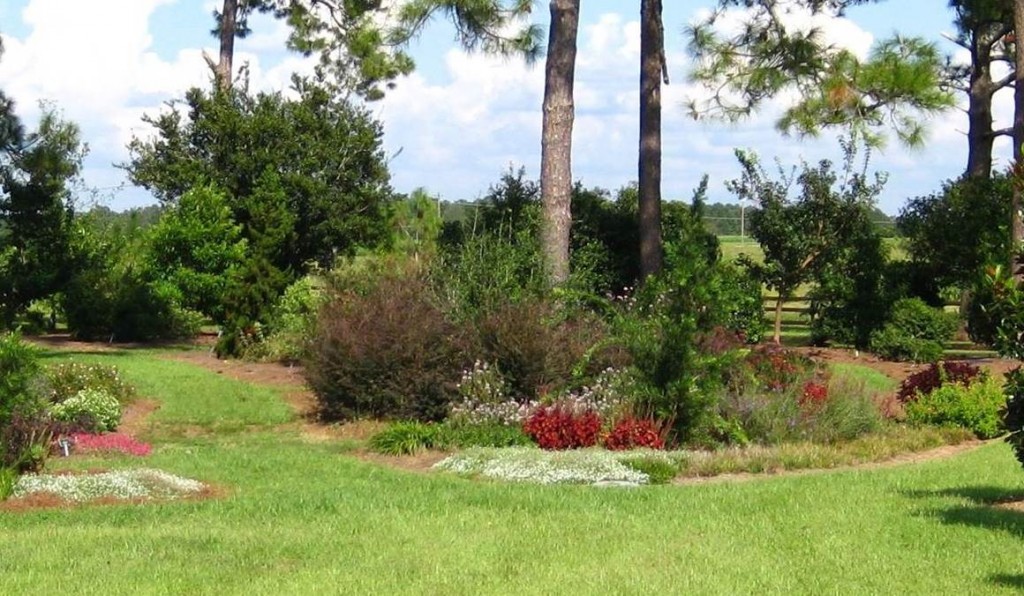
The Discovery Garden, showcasing new plants, in Gardens of the Big Bend at UF/IFAS North Florida Research and Education Center, Quincy.
The University of Florida Institute of Food and Agricultural Sciences presents “Art & Garden,” Saturday October 5, at the North Florida Research and Education Center (NFREC) in Quincy. The free event will highlight creative ways to explore visual art and the art of gardening.
Spend the day learning, discovering and engaging in fun activities for the whole family. Learn about floral arranging, container gardens, native plants that attract wildlife, and combating pests and invasive plants in your garden. Join a walking tour of the Gardens or take a trolley tour to view cold-hardy citrus and deciduous fruit. Watch plein-air artists painting on-site throughout the garden. Discover how to make mosaic stepping stones as well as birdbaths from large leaves. Children can spend the day painting pumpkins, planting sweet potato sprouts to take home, or painting, drawing, and making birdfeeders with staff and volunteers from the Gadsden Arts Center.
An exciting array of trees, shrubs, flowers, organic produce and arts and crafts will be for sale. NFREC staff will be offering free soil testing and a plant disease clinic, so bring a sample of your soil or a clipping of a plant problem from your home garden. The day-long, family-friendly event is free and open to the public.
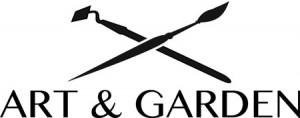
When:
Saturday, October 5, 9:00 am to 4:00 pm EDT
Where:
University of Florida/IFAS, North Florida Research and Education Center, 155 Research Road, Quincy, FL. Located just north of I-10 Exit 181, 3 miles south of Quincy, off Pat Thomas Highway, SR 267.
Who:
Presented by the University of Florida Institute of Food and Agricultural Sciences, North Florida Research and Education Center in collaboration with the Gadsden Arts Center, Gardening Friends of the Big Bend, Havana Garden Club, Quincy Garden Club, and the Tallahassee Plein-Air Artists. Sponsored in part by the Gadsden County Tourist Development Council.
Saturday’s Program:
Plant, produce and art sales by vendors
- 9:30 am Walking Tour of the Garden with Dr. Gary Knox—See new plants and capture information on your smart phone via QR codes
- 10:00 am How to Make Mosaic Stepping Stones
Wendy Adams, Havana Garden Club
Garden Pavilion
- 10:30 am Trolley Tour — Cold Hardy Citrus and Deciduous Fruits
Dr. Pete Andersen and Dr. Russ Mizell
- 11:00 am Floral Arranging Demonstration
Kay Edwards, Quincy Garden Club
Garden Pavilion
- 12:00 am Art Lecture, “Getting a Lay of the Land”
Dr. Katerie Gladdys, University of Florida School of Art
Exhibit Hall
~ First Silent Auction ends ~
- 1:00 pm How to Make and Decorate Elephant Ear Birdbaths
Cathy Boatright, Havana Garden Club
Garden Pavilion
- 1:30 pm Trolley Tour — New Plastic Mulches for Vegetable Production
Dr. Josh Freeman
- 2:00 pm How to Make a Container Garden
Dr. Gary Knox
Garden Pavilion
- 3:00 pm Walking Tour of the Garden with Dr. Gary Knox – See new plants and capture information on your smart phone via QR codes
~ Second Silent Auction ends ~
- 3:30 pm Raffle Winner Announced and Children’s Art Show Best in Show Announced
By Dawn McMillan and Gary Knox
by Blake Thaxton | Sep 23, 2013
It has been a hot summer but Fall is right around the corner. Cooler temperatures and changing colors are a welcomed change in the panhandle of Florida. Fall can be a great time to spruce up your landscape with some new shrubs.
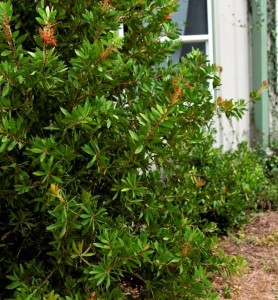
Image Credit UF / IFAS
It may be time for your landscape to receive a mini-makeover and to get a new look for fall and years to come. Perhaps some shrubs strategically placed will be what makes your outdoor living space pop. Proper selection and installation is key to health of the shrub moving forward.
Selection
There are several factors that need to be taken into account before buying shrubs to add to your landscape. Carefully selecting plants based on the following points will help with long term success of the plant:
- Climate – Be sure that the species will tolerate the climate you live in.
- Environment – Study the light level, acidity, and drainage of the planting site.
- Space – Account for the mature size of the plant before planting. This will keep you from having to remove the plant if the space is not adequate.
- Inspect the plant – Check for mechanical injury (scars and open wounds), cold injury, condition and shape of the canopy, and examine the root system.
Installation
Now that the proper plant has been selected it is time to give the shrub the best chance for survival with proper installation techniques. Fall and winter is an ideal time for planting shrubs. The roots can develop before the tops begin to grow in spring. The following are the keys to proper establishment of container shrubs.
- Root ball preparation – Remove the container from the root ball and inspect for circling roots. If there are circling roots than make three or four cuts vertically to cut the roots. Pull some of the roots away so they will take on a new growth direction (massage the roots). Also find the top most roots as sometimes they are covered by extra potting media. Remove the extra potting media so the top most roots are exposed and become the top of the root ball.
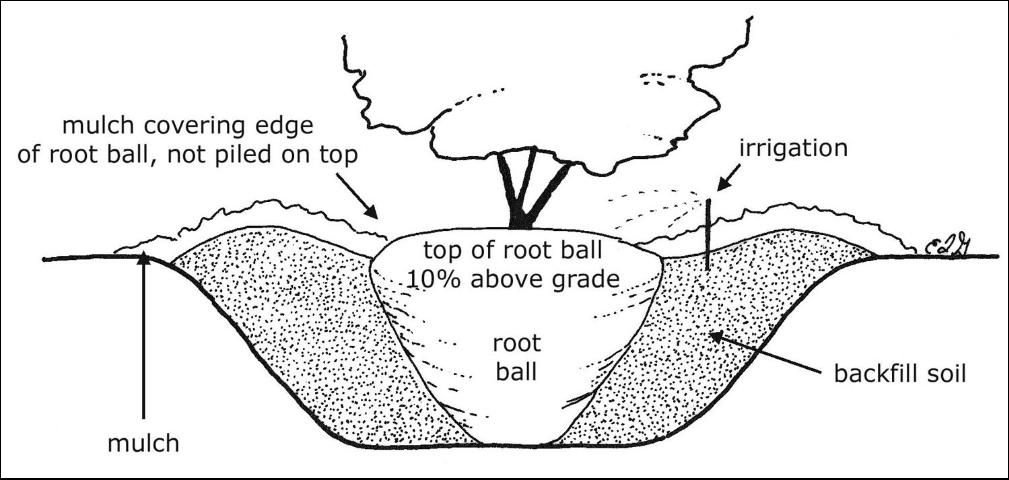
Image Credits: UF/IFAS, Edward F. Gilman
- Wider is better – Dig the hole two or three times the diameter of the root ball.
- Proper depth – Make sure to dig the hole 10% less than the height of the root ball. In poorly drained soils dig the hole 25% less than the the height of the root ball. The top most roots should be slightly above the native soils.
- Backfill – Fill the hole with existing soil half way and tamp the soil to settle. Again fill the rest of the hole with the existing soil and tamp again to settle the soil. Do not place any backfill soil or mulch over the root ball as it is crucial that water and air are able to be in contact with the the roots.
- Aftercare – Irrigate daily for the first two weeks, followed by every other day for the next two months, and weekly until the shrub is established (For <2 inch caliper shrubs).
If these key points are followed regarding selection and installation, the shrubs will be well on their way to becoming established in the landscape. If you would like read more in detail about installation please read the following:
Specifications for Planting Trees and Shrubs in the Southeastern U.S.
Literature:
Gilman, E.F., (2011, August) Specifications for Planting Trees and Shrubs in the Southeastern U.S.. Retrieved from: http://edis.ifas.ufl.edu/ep112
Black, R.J. and Ruppert, K.C., (1998) Your Florida Landscape, A complete guide to planting & maintenance. Gainesville, FL: University Press of Florida.
by Mary Salinas | Sep 23, 2013
Is the newest growth on your sago palm turning yellow, brown, frizzy looking and dying – is it a pest or disease or something else?
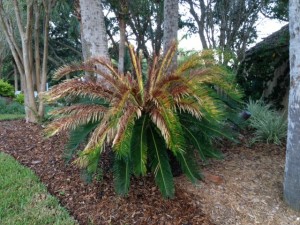
Photo credit: Mary Derrick
This sago palm is suffering from a classic case of manganese deficiency. When sago palms lack manganese, the newest leaves will develop yellow splotches or be entirely yellow. As the leaves die, they turn brown and take on a frizzled appearance. Sometimes the leaves or fruit may be smaller than normal. If left unchecked, the sago usually dies.
Manganese is a micronutrient required by all plants for normal, healthy growth and is most available for plant uptake when the soil pH is between 5.5 and 6.5. Soils in the Florida panhandle are often naturally low in manganese and then what available manganese is present can be unavailable for the plant to use if the pH of the soil is much above 6.5. Also, manganese tends to be leached from the soil when the pH is below 5.5. Soil pH and nutrient testing is useful to determine if soils are nutrient deficient. Contact your county Extension office for information on getting that done.
[notice]Before treating, rule out an infestation of Asian cycad scale. Click here for a UF IFAS Extension publication on this damaging insect. Be aware that both are common problems for sago palms and that your sago may be afflicted with both![/notice]
If this is happening to a sago palm, the good news is that it is easy to correct. Manganese sulfate is readily available at garden centers, feed &seed stores and independent nurseries. Just make sure to get manganese sulfate and don’t confuse it with magnesium sulfate (Epson salts). The amount of manganese sulfate necessary to correct this deficiency will vary with its size, soil type and pH. Sago palms in sandy, acidic soils require less manganese sulfate than those in high pH soils. One ounce is sufficient for a very small plant in sandy, acidic soil. A very large sago in a high pH soil may require about five pounds, however. Spread the product evenly over the root zone and water in with about a half inch of water.
The affected leaves cannot be cured but new growth should return to normal. If the new growth is still affected, an additional application of manganese sulfate may be needed. Once sago palms have suffered from a manganese deficiency, half the initial rate should be applied yearly to prevent the deficiency from re-occurring.
Even though sago palms are not true palms – they are cycads – their nutritional needs are very similar to palms. Most of the time they grow well without any supplemental fertilization, but if they do need fertilizing, use a 8-2-12-4 (the fourth number is magnesium) palm fertilizer with micronutrients and avoid using other fertilizer products in their root zones.
For more information on sago palms please see:
Cycas revoluta, Sago Palm
by Alex Bolques | Sep 23, 2013
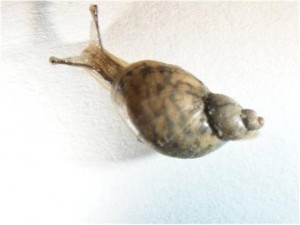
Cone Shaped or Cone Shell Snail Photo Credits: Heather M. Young, Biological Scientist, NFREC-Quincy
Occasionally on shipments of container plants, snails (terrestrial air-breathing gastropods) may be found attached to the container pot. Snails are abundant in nearly all parts of the world except the arctic regions, and feed almost entirely on vegetation. Those mostly encountered on nursery container plants are cone shaped reaching 1/2 to 2 1/2 inches in length and having an external enclosing spiral shell or occasionally rounded shell with four to five rapidly expanding whorls that are 1 to 1 1/4 inches in size.
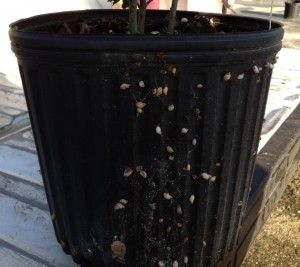
Image Credit: Henry Grant, Gadsden County Extension.
There are many species of snails. Most snails found on shipments are those restricted to tropical and semitropical regions requiring high humidity and warm temperatures. The U.S. has four native genera of Bulimulidae: Rhabdotus, Drymaeus, Orthalicus and Liguus. Of these, the last three genera are native to Florida. There is also another introduced genus in Florida, Bulimulus, which is primarily terrestrial. Other introduced species are Zachrysia provisoria and Caracolus marginellus in the Family Camaenidae occurs in Florida and found throughout much of the tropics.
Snails are also found in moist, shaded locations, which are similar to conditions found in container plant production areas, weedy locations or in organic trash. Most lay eggs throughout the season. Overwintering eggs may hatch in spring.
The following are general snail management suggestions:
- Remove excess organic material under plants. Organic materials provide moist hiding places for eggs and smaller snails, and sometimes as food sources.
- Monitor plant and environment moisture to reduce favorable snail habitats.
- When possible, remove the snails by hand, which is a reasonable, effective, nontoxic and environmentally acceptable control option.
- Check with your favorite garden store outlet for bait, biological, or chemical product control options.
For more information check out this gardening in a minute segment on snails and slugs.
by Larry Williams | Sep 16, 2013
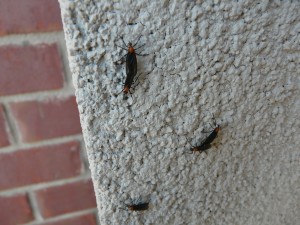
Adult lovebugs on building, Photo Credit: Larry Williams
Contrary to popular belief, lovebugs were not introduced to the state by the University of Florida. This insect is an invasive species from Central America. Lovebugs migrated from Central America, traveling through Texas and Louisiana to get to Florida. They were first reported in Florida during the late 1940s. They are now found throughout the state. Prevailing winds, vehicle traffic, sod transport, increased habitat along highways and expansion of pastures may have assisted the movement of lovebugs throughout Florida. UF researchers had nothing to do with it.
Even though it’s an interesting story, University of Florida researchers did not genetically engineer lovebugs to kill mosquitoes. A complete understanding of this insect will prove that this could not have possibly been the case. First, lovebugs do not feed on insects. They feed on pollen and nectar found in flowers. Secondly, they lack mandibles (jaws) and grasping legs to hold onto and eat mosquitoes. Thirdly, they are slow flying insects that lack speed to go after mosquitoes. Additionally, lovebugs are active during the day (usually between 10 a.m. and 4 p.m., in temperatures above 84°F). Most mosquitoes are out during the evening and night. Finally, lovebugs are only adults for a few weeks each year. The lovebug is a poor candidate to genetically engineer as a mosquito predator, even if it were possible.
Female lovebugs are attracted to UV irradiated aldehydes, a major component of automobile exhaust fumes. They may confuse these chemicals with odors emitted from decaying organic matter where the female deposits her eggs. Heat also has been shown to attract lovebugs and may be another reason for their abundance along highways.
Lovebug larvae feed on decaying plant material, assisting with converting plant debris into organic components that can again be used by the growing plants.
Adult lovebugs are active during late April and May and again August and September. Each flight lasts for a four to five week period.
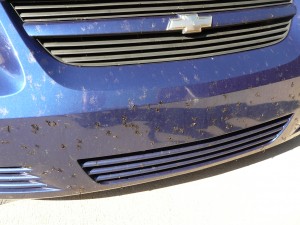
Lovebugs splattered on car, Photo Credit: Larry Williams
Even though lovebugs can be a problem as they splatter on our automobiles, be thankful that they don’t bite, sting or hang around all year.









